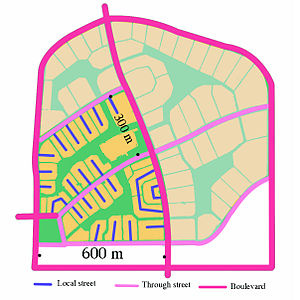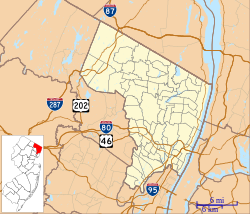Radburn, New Jersey | |
|---|---|
 A diagram showing the street network structure of Radburn and its nested hierarchy. Separate pedestrian paths run through the green spaces between the culs-de-sac and through the central green spine (the shaded area was not built). | |
| Coordinates: 40°56′33″N 74°07′00″W / 40.94250°N 74.11667°W | |
| Country | |
| State | |
| County | Bergen |
| Borough | Fair Lawn |
| Elevation | 95 ft (29 m) |
| Time zone | UTC−05:00 (Eastern (EST)) |
| • Summer (DST) | UTC−04:00 (EDT) |
| GNIS feature ID | 879582[1] |
Radburn | |
 A Radburn cul-de-sac | |
| Location | Fair Lawn, New Jersey |
|---|---|
| Built | 1928 |
| Architect | Clarence Stein, Henry Wright |
| Architectural style | Colonial Revival, Tudor Revival |
| NRHP reference No. | 75001118[2] |
| NJRHP No. | 482 |
| Significant dates | |
| Added to NRHP | April 16, 1975 |
| Designated NHLD | April 5, 2005[3] |
| Designated NJRHP | October 15, 1974 |
Radburn is an unincorporated community located within the borough of Fair Lawn in Bergen County, in the U.S. state of New Jersey.[4]
Radburn was founded in 1929 as "a town for the motor age".[5] Its planners, Clarence Stein and Henry Wright, and its landscape architect Marjorie Sewell Cautley[6] aimed to incorporate modern planning principles, which were then being introduced into England's Garden Cities, following ideas advocated by urban planners Ebenezer Howard, Sir Patrick Geddes[7] and Clarence Perry. Perry's neighborhood unit concept was well-formulated by the time Radburn was planned, being informed by Forest Hills Gardens, Queens, New York City (1909–1914), a garden-city development of the Russell Sage Foundation.
Radburn was explicitly designed to separate traffic by mode,[7] with a pedestrian path system that does not cross any major roads at grade level. Radburn introduced the largely residential "superblock" and is credited with incorporating some of the earliest culs-de-sac in the United States.[8] It was designated a National Historic Landmark District in 2005, in recognition of its history in the development of the garden city movement in the 20th century.[9]
- ^ a b "Radburn". Geographic Names Information System. United States Geological Survey, United States Department of the Interior.
- ^ "National Register Information System". National Register of Historic Places. National Park Service. January 23, 2007.
- ^ "Radburn". National Historic Landmark summary listing. National Park Service. June 23, 2008.
- ^ Locality Search, State of New Jersey. Accessed March 7, 2015.
- ^ History Archived 2011-06-10 at the Wayback Machine from the Radburn Association website
- ^ Marjorie L. Sewell Cautley, Landscape Architect to the Garden City Movement by Thaisa Way, accessed June 7, 2006
- ^ a b Introduction from the Radburn Association website
- ^ Cul-de-Sacs: Suburban Dream or Dead End?, a June 2006 National Public Radio story
- ^ "NHL nomination for Radburn". National Park Service. Retrieved May 1, 2021.


